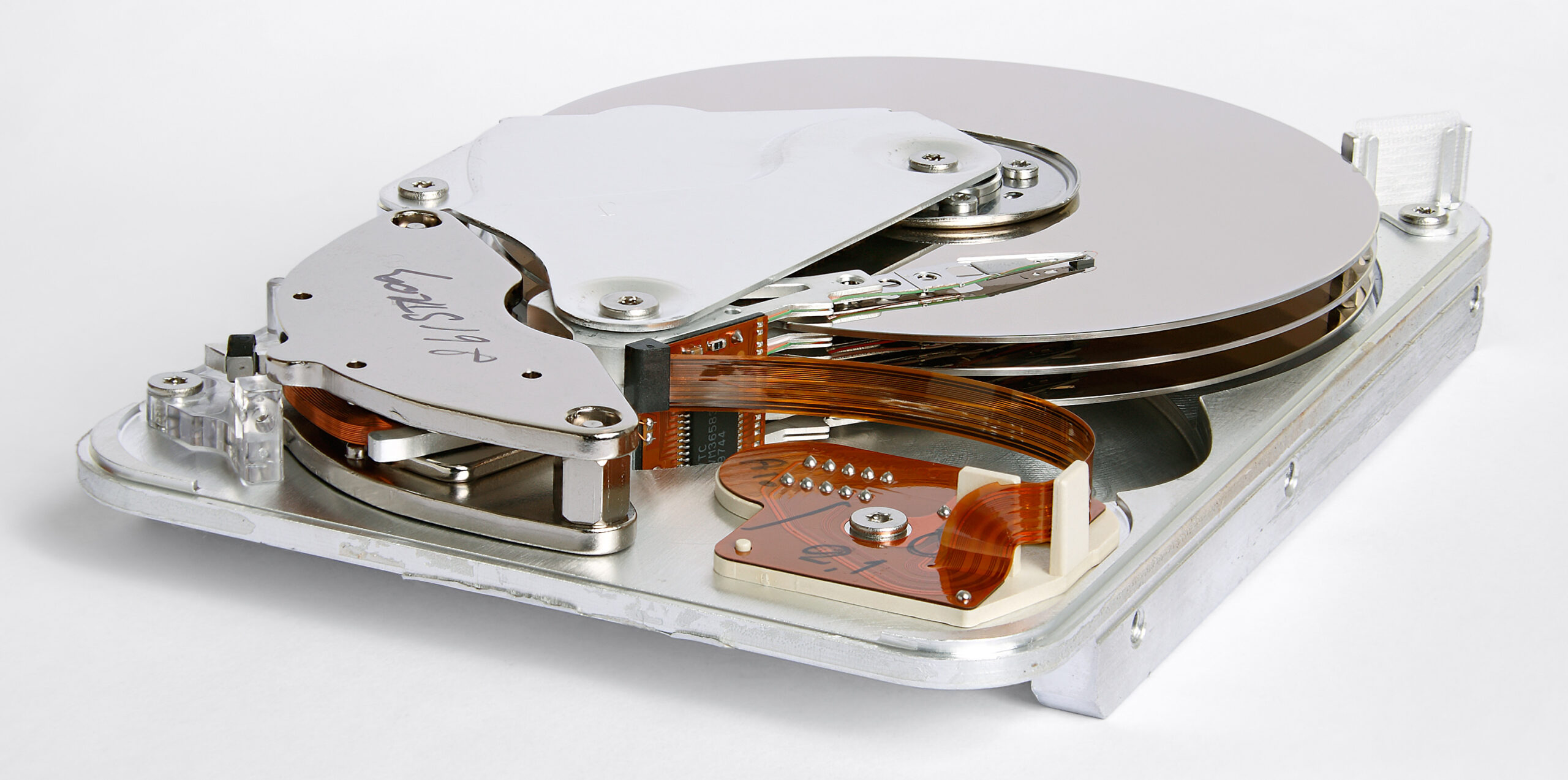
It is possible to have a computer which does not have secondary storage. This comes with one huge disadvantage: when you turn the power off you lose everything and have to start from scratch. This may sound like complete madness, but actually it wasn’t so long ago that this was totally normal in computing and gaming.
Games consoles like the PS1 and PS2 had no secondary storage, if you turned them off you’d have to load a game from scratch again next time you turned them on. You could attach memory cards which allowed you to store progress or score data, for example, but not entire games – you needed the disc for each and every game.
In modern consoles, computers, tablets and phones, secondary storage is used to store an operating system, any programs (apps) you may want and your data. The way in which this data is kept permanently will differ depending on the device, its size and the amount of data you need to store.
In this section we investigate all of the commonly available methods of storing programs and data in a non-volatile environment.
Click below to jump to a specific section:
- The difference between Memory and Storage
- Storage Quantities
- Magnetic Storage
- Optical Storage
- Solid State Storage
- Cloud Storage
- The right tool for the job
The difference between Memory and Storage
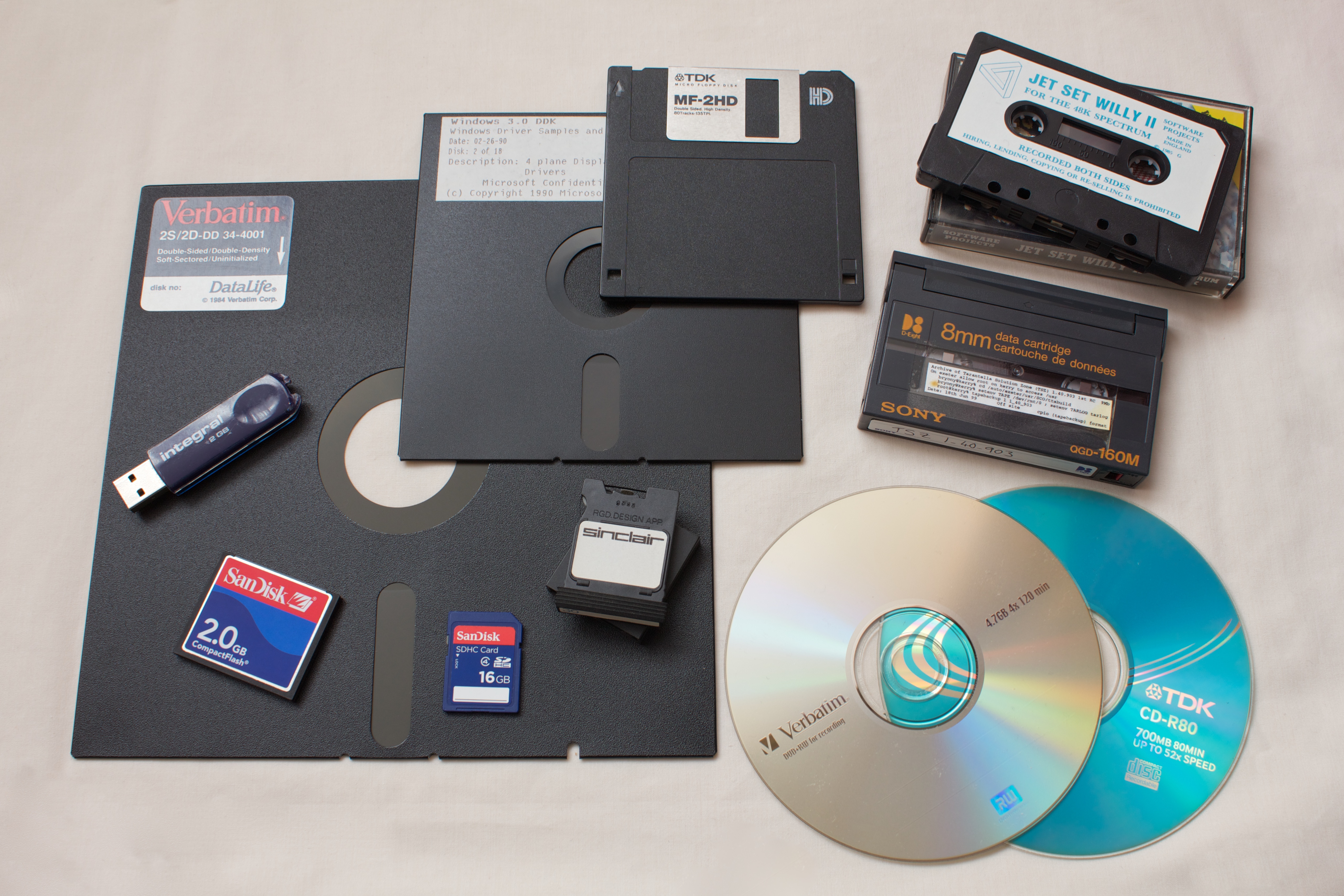
Before we talk about storage, do not lose sight of the following facts:
- All data in a computer is simply a collection of 1’s and 0’s.
- Therefore, all data storage methods are just containers that can hold many millions of 1’s and 0’s
The key terms storage and memory are often misunderstood and mixed up in exams – they are not interchangeable so we must know the difference.
Memory refers to any volatile storage which acts as a temporary working area for open, running programs and data.
Volatility, remember, refers to the stability of a component. If a component is volatile, then data will be lost when power is turned off. Non-volatile means that data is retained (not lost) when power is turned off, in other words it is stable.
Storage then, is a device which provides mass, non-volatile, permanent storage for programs and data.
Put simply, a “storage device” is the thing that holds all of your data, applications and anything else you don’t want to lose from one power cycle to another. This is the device that means you don’t have to start from scratch every time you turn a machine on and enables you to “save” things.
There is one other important difference between memory and storage that we need to be aware of.
RAM (memory) will have a far smaller capacity (how much data it can hold) than a storage device. However, RAM is much faster than any storage device and therefore gives us a performance boost when used as a working space. Having both RAM and storage in a system gives us the best compromise between cost, storage space and system performance.
Exams often ask why we need storage if we have RAM or vice-versa and the answer is:
- RAM is needed for speed – it enables the CPU to work quickly with programs and data
- RAM, however, is much smaller than storage and is volatile, meaning the contents is lost when the power is turned off…
- …therefore we need storage to enable us to persistently store data and to enable the storage of large quantities of programs and data.
Storage Quantities
We know that storage is a non-volatile place where we store 1’s and 0’s without losing them when the power is turned off. Now we need to turn our attention to how we measure the quantity of binary data that each device can store.
You’ll have heard the terms Gigabyte and Megabyte (especially when it comes to your mobile phone data allowance or contracts) but what do these actually mean?
If we take a detour for a moment and look around, you will see measurement systems are in use everywhere. How far was it to school this morning? 5km? How tall are you? 176cm? How much does a bus weigh? 5000Kg?
Focusing on one of those systems, weight, every single one of you will know the following:
The smallest unit of weight we usually use is the gram. 1g of something is not a lot at all, for example the average spoon full of sugar will weigh approximately 15g.
What if we have a lot of something? It would be silly to write “The weight of an average car is 23029201 grams.” Instead we write “2.3 tons” There is obviously a scale being applied here:
- 1 unit = 1 gram
- 1000 grams = 1 Kilogram (Kg)
- 1000 Kg = 1 Ton
- 1000 Tons = 1 Kiloton
- 1000 Kilotons = 1 Megaton
- 1000 Megatons = 1 Gigaton
Take notice of the words that are used here – Kilo, Mega and Giga as these are common to different measurement systems and we make use of them in computing to measure quantities of data.
Let’s get back to computing storage quantities.
First of all the smallest quantity we can store in a computer us a single zero or one:
- a 0 or a 1 = a Bit
Then we start grouping many bits together to make bigger quantities:
- 4 bits = a Nybble (no I didn’t make it up.)
- 8 bits = a Byte
- 1024 Bytes = 1 Kilobyte (Kb)
- 1024 Kilobytes = 1 Megabyte (Mb)
- 1024 Megabytes = 1 Gigabyte (Gb)
- 1024 Gigabytes = 1 Terabyte (Tb)
It shouldn’t be too hard to spot the pattern and this is what makes it easy to remember. As soon as you know 8 bits = a byte, then every quantity after that is 1024 of the previous amount.
That would be too easy if we just left it there, wouldn’t it?
Have you asked yourself why we are using multiples of 1024? The answer is because these storage quantities are powers of 2 (2 because we are using a binary number system). Why does this matter?
It matters because somewhere in the not so distant past, the computing community decided to redefine these storage quantities to be powers of 10, or multiples of 1000 rather than 1024. This makes it easier to perform calculations in your exam and harder for anyone to follow what on earth is going on.
The following table from IBM shows what we are talking about:
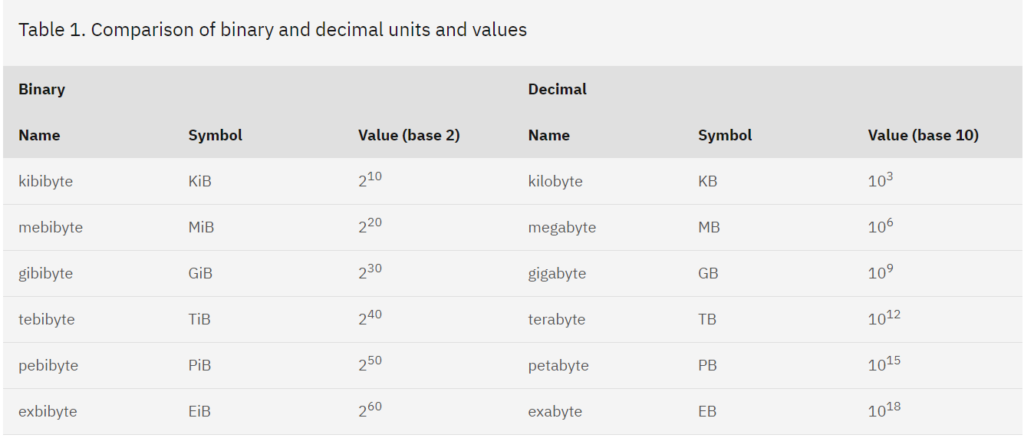
Notice that the names have swapped. A Gigabyte now is 1000 megabytes. The “old” terms now have different names. How confusing.
Our “new” table now looks something like this:
- 4 bits = a Nybble (no I didn’t make it up.)
- 8 bits = a Byte
- 1000 Bytes = 1 Kilobyte (Kb)
- 1000 Kilobytes = 1 Megabyte (Mb)
- 1000 Megabytes = 1 Gigabyte (Gb)
- 1000 Gigabytes = 1 Terabyte (Tb)
Please note, no one in the exam is going to be pedantic enough to mark you down or wrong for mixing up “megabyte” and “mebibyte” for example, so just use the words above interchangeably whether you are using powers of 10 or powers of 2. It doesn’t matter.
My advice on this is as follows:
- In the exam, use multiples of 1000
- Computers, regardless of what anyone else is doing, will always measure storage using powers of 2, and therefore the “old” multiples of 1024.
- This explains why when you buy a “1tb” SSD for your PS5, it sees it as being around 900Gb. It is using a different storage scale!
The scale of this storage loss can be seen in the table (also by IBM) provided below:
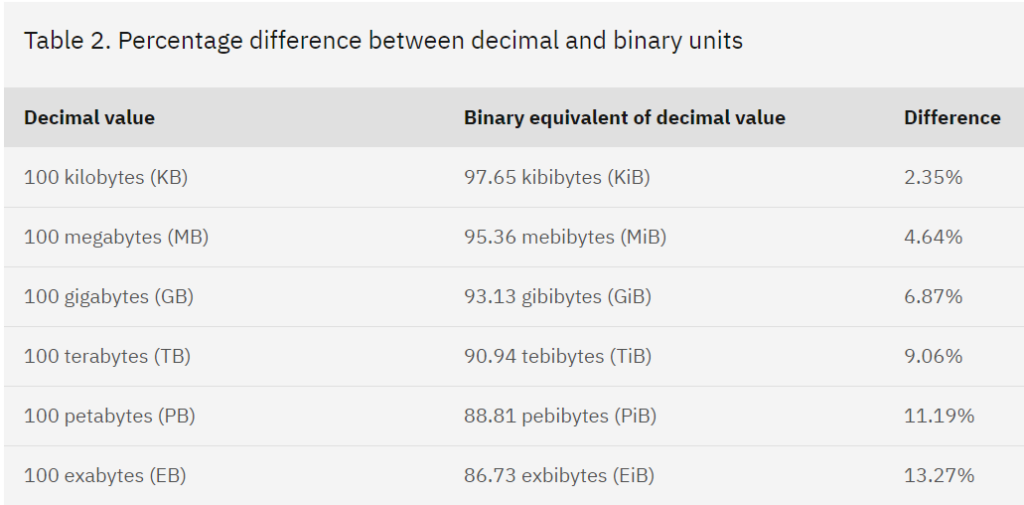
Calculating and converting storage requirements
To put things into perspective and help you attach some meaning to these storage quantities, here are some ball park, typical file sizes for things you should know about (from small to large):
- Text file – 100Kb
- Picture taken on your phone – 4Mb
- Film recorded in HD – 1Gb
- Your entire film and music collection all stored in one place – 1Tb
- More data than you can ever imagine or quantify – 1Pb
Just as an aside, if you took a picture that was 5Mb in size, you’ve just created 41,943,040 bits of information. 41 million bits! Now you perhaps have some idea of the amount of data that is needed to create/manipulate/process something which seems insignificant. This also explains why computers have to be so fast – there is simply so much data that needs to be processed.
When OCR changed the specification for the computing exam, they decided you need to be able to convert between the different storage quantities and also to calculate how much storage space would be required in a given scenario.
Examples of questions might be:
“How many gigabytes are in 2 terabytes?”
“A storage device has 2gb free space, how many 300mb videos could fit in the available space?”
To answer these questions you will need to be able to convert from one storage quantity to another.
Conversions and Calculations
You are likely to be asked to perform simple conversions between the different binary storage quantities. Below is a typical question from the November 2020 Unit 1 exam paper:

The question gives you two key pieces of information:
- There are 80 gigabytes of space available
- Files are 200,000 kilobytes in size
To answer any of these questions, you must know your storage quantities inside out. Lets repeat our table from earlier as a reminder:
- 8 bits = a Byte
- 1000 Bytes = 1 Kilobyte (Kb)
- 1000 Kilobytes = 1 Megabyte (Mb)
- 1000 Megabytes = 1 Gigabyte (Gb)
- 1000 Gigabytes = 1 Terabyte (Tb)
To answer this question we need to convert one of the quantities so that the units match – in other words, we need to be working with gigabytes and gigabytes.
Conversions are really easy if you can remember the order in which these units go. To convert “up” the scale, from bytes to kilobytes to megabytes and so forth, simply divide by 1000. To convert “down” the scale, from megabytes to kilobytes to bytes and so forth, simply multiply by 1000. The diagram below illustrates this:

Going back to our question, how many 200,000 Kilobyte files can fit into 80 Gigabytes?
- 200,000 Kilobytes / 1000 = 200 Megabytes
- 200 Megabytes / 1000 = 0.2 Gigabytes
- 80 Gigabytes / 0.2 Gigabytes = 400 files
Alternatively you could do:
- 200,000 Kb / 1000 = 200 Megabytes
- There are 1000 Megabytes in a Gigabyte, therefore 1 Gigabyte can store 5 files (1000/200)
- 80 Gigabytes * 5 files per Gigabyte = 400 files
Magnetic Storage
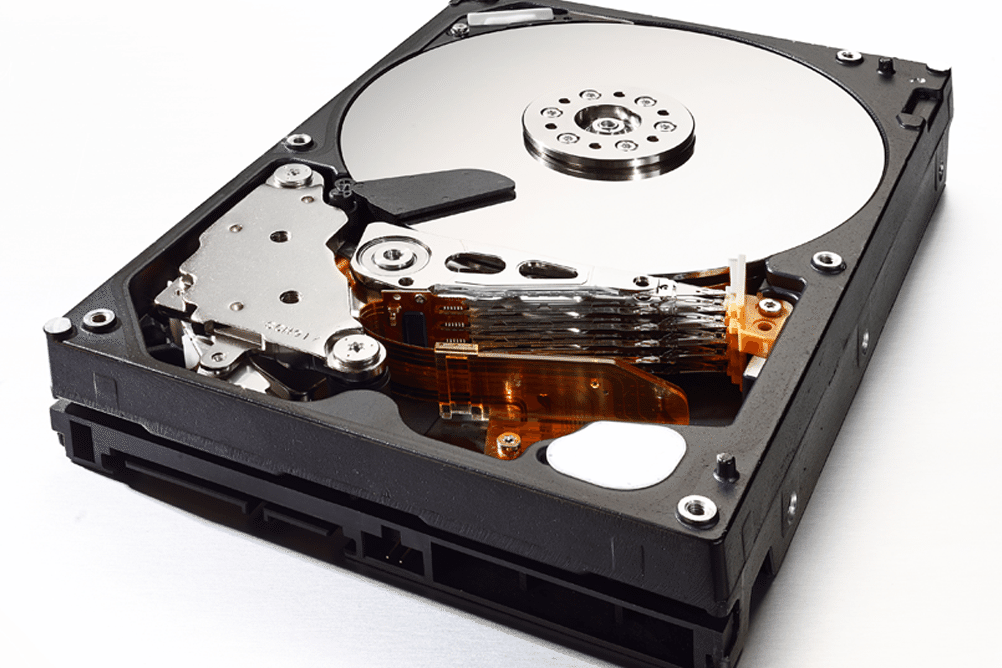
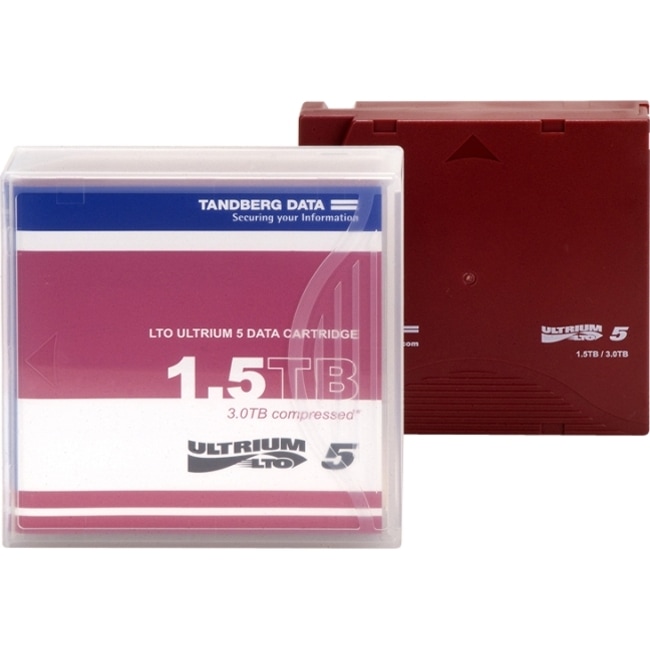
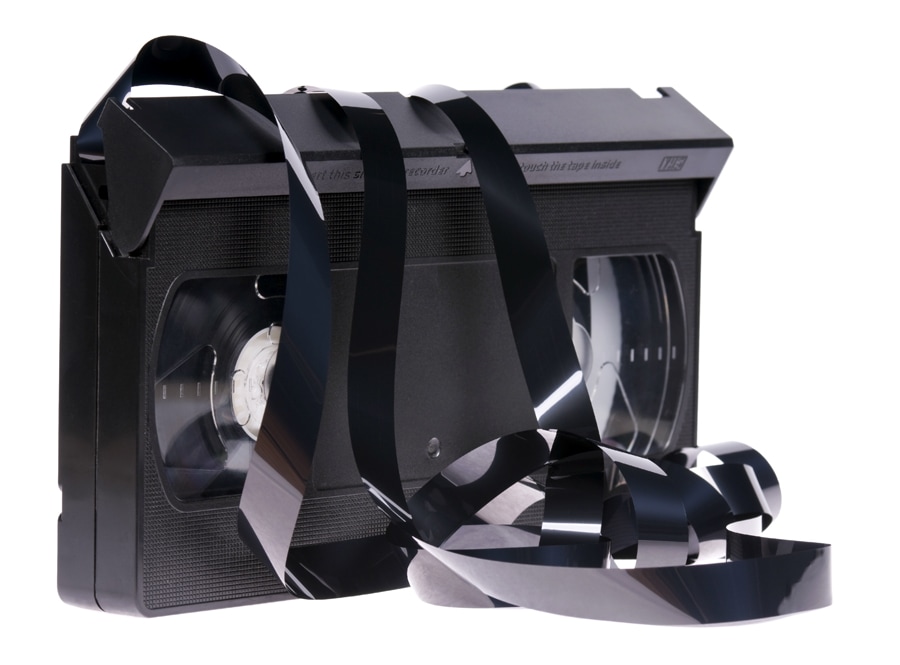
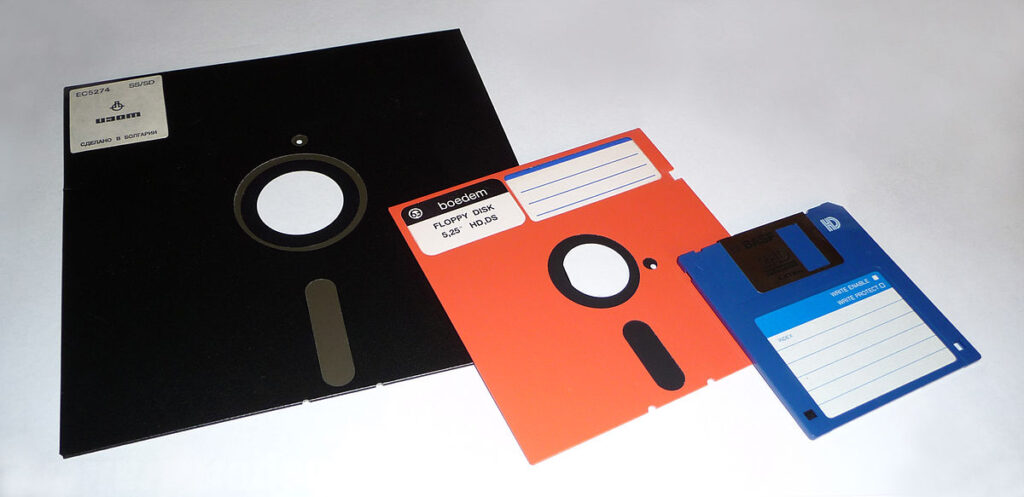
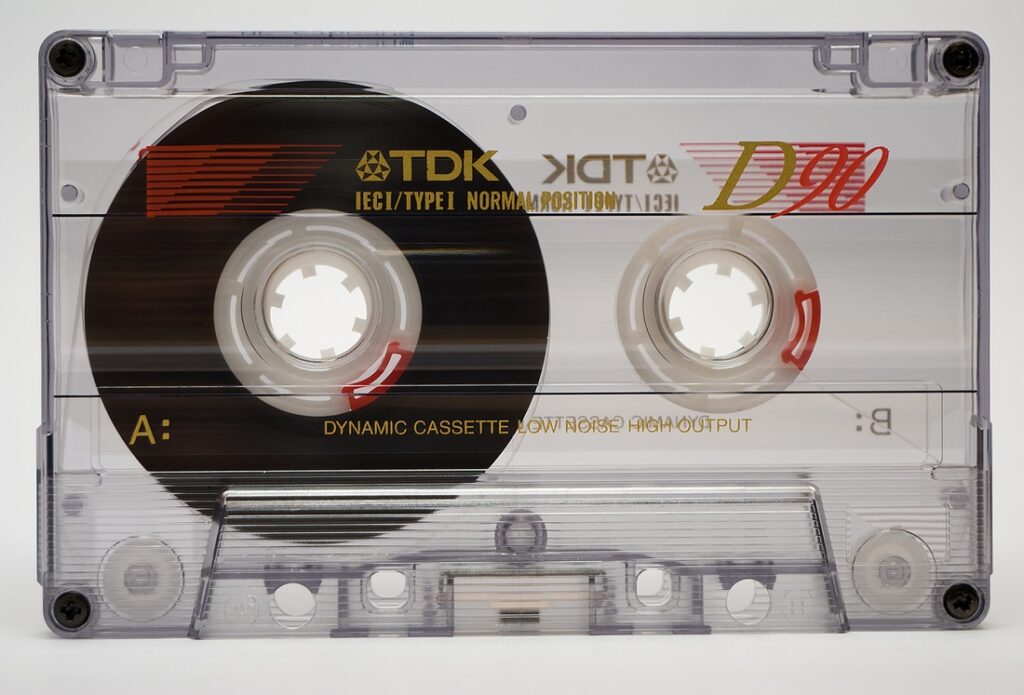
History
Magnetic storage is as old as the hills. It’s up there with the dinosaurs in technology terms, yet until very recently, its been seemingly impossible for the computing world to move away from it.
Magnetic storage first started out in the form of tapes – big old reel to reel things, then cassette tapes (which stopped the tape getting so easily damaged). These stuck around for decades before other forms of storage took over. In the 1990’s you’d probably have listened to your music on a Sony Walkman which played cassette tapes, or if you were properly rich, you may have even had a mini disc player.

When computers became more mainstream, cassette tape was the obvious way to store programs and data – the technology was already in homes and, more importantly, it was really very cheap. The only problem with it was speed – reading and writing data to tape is a slow, slow process.
Things moved on and machines started to come with floppy disk drives. These used similar technology – the disk had a magnetic coating which was used to store data. These had the advantage that they were slightly less bulky in physical size, could hold more data than a tape and were much, much faster to read and write.

Floppy disks stuck around for a phenomenal amount of time. They first appeared in the 1970’s and weren’t fully phased out until around 2010 – in technology terms this is the equivalent to about 3000 years. Unbelievably, floppy disks have held on in some applications even longer, with the US military only phasing out floppy disks as late as 2019.
The reason for this is that they offered a convenient way of moving data from one place to another – they were easy, very cheap removable storage. Until solid state storage (read more below) became much, much cheaper and USB memory sticks appeared there wasn’t a convenient removable storage medium to replace floppy disks with.
To be clear, you don’t need to talk about any kind of floppy disks in your exam, but it is useful to know where magnetic storage technology began and how it was used.
Hard drives
Finally on to a type of magnetic storage that you do need to talk about in your exam – hard drives. When hard drives became mainstream and affordable they were a complete revelation. For the first time, computers came with large amounts of non-volatile storage that could even be upgraded as necessary. This was a total game changer.
Before hard drives, all software was stored on individual disks and every time you turned your computer on you had to load a program from disk, then maybe change the disk to load your work files, then swap the software disk back and so on. Having a hard drive meant that all of a sudden you could install (copy it to the hard drive) your software and it would still be there when you turned the computer on again the next day – crazy stuff.
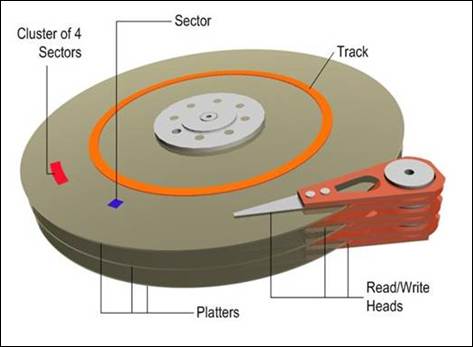
Hard Disk drives consist of big shiny metal discs called platters. These platters are covered in an iron oxide coating, which as you should know from your science lessons is… Rust. But it’s also really quite good for use in magnetic storage.
These platters spin round at high speed, between 5200 – 7200 RPM and data is stored in circular tracks on the disk. To read and write the data, a mechanical arm sits at the side of the disk and moves a very small electromagnetic “read/write head” over the surface.
Why am I telling you how they work? Because it really helps explain some of the advantages and disadvantages. Lets summarise what we know so far:
- Hard Drives are magnetic storage
- They store data on spinning discs called platters
- They provide large amounts of storage – 1TB at least, up to 22TB (or more in future) per drive.
Advantages:
- They are cheap. Absurdly cheap. At present they are the cheapest type of storage per GB available. At present prices you are paying approximately 2p per gigabyte!
- They offer very high storage capacity – up to 22TB per drive and rising
Disadvantages:
- Now we have SSD storage, Hard Drives are painfully slow in comparison. This is because it takes time to spin the disc, then get the read head to the correct position, wait for the correct sector to arrive under the read head and so on. All these things slow them down.
- They have moving parts – this means they will eventually wear out.
- They can be badly damaged by shock, movement, drops etc. Again, this is because they have moving parts. If the read/write head touches the platter then data can be destroyed.
- They are large (compared to flash/SSD storage) and consume more power than solid state alternatives. This means they are not good choices for small or portable devices and anything that relies on battery power.
Magnetic Backup Tape
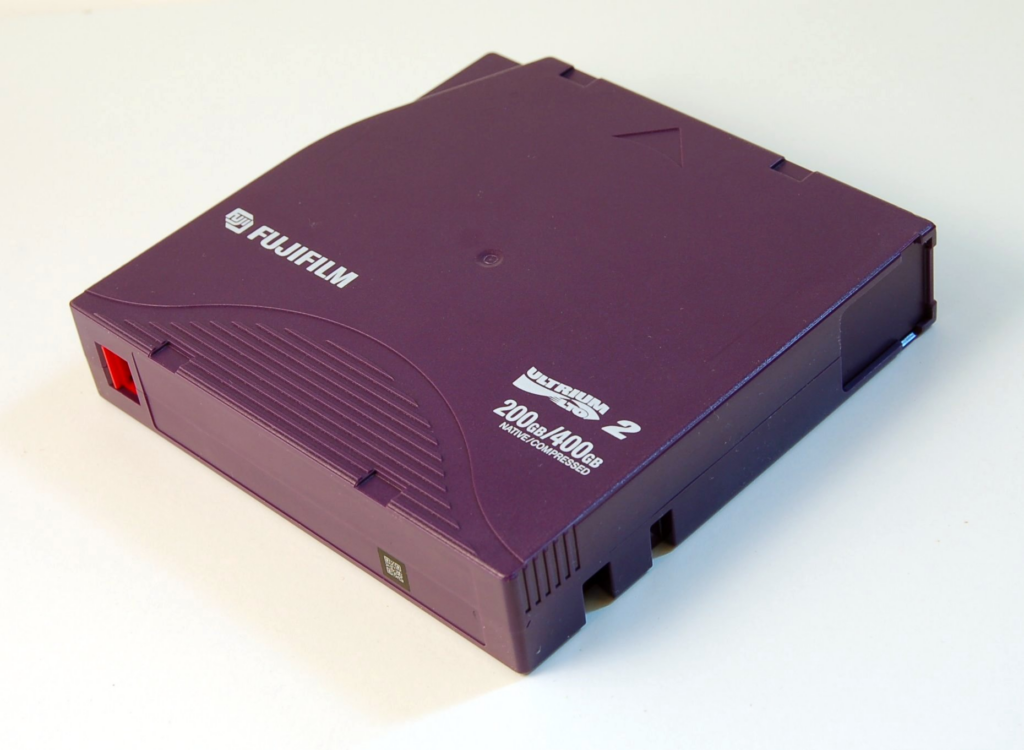
I mentioned tapes previously in the section on the history of magnetic storage. It turns out that magnetic tape is still very much in demand today for one very specific use – backup.
Tape storage technology has moved on significantly in recent years with IBM now having developed a single tape which can store 20 terabytes of data. As of writing, that is at the same level of storage capacity than the very largest single hard disc drive available.
Tape is an attractive technology for backup because it is:
- Very cheap
- Extremely reliable
- High storage capacity
- Small, removable and easy to store in a fire proof safe
These features mean that any organisation of a reasonable size (say a school or medium sized office) up to the very largest companies will make use of tape to back up all of their data. These backups are incredibly valuable and so the fact that tape is small and portable makes it ideal for either storing in a robust, fire proof safe or even being taken away and stored in an entirely different building. Should a disaster strike, the company can retrieve the tapes and start from scratch without losing work.
There are a few disadvantages of tape, however, the main one being that tape is accessed in a serial manner. What does this mean?
Serial means “one after the other” – data is written to tape one piece after another. This is effectively a queue system, the first person in the queue is the first one out. The last person in the queue is the last person out of the queue. The same is true for the reading and writing of data in a serial manner.
Data goes on to tape one piece after another until all data has been written. To get data off a tape, it must all be read back in order until you find the piece you are looking for. This means you cannot jump to a specific piece of data on a tape, you have to read all the data until the piece you want is found. Obviously, if the data you want is stored near the end of the tape, it can take a very long time to find it and then read back.
In summary, disadvantages of tape are:
- Slow to read and write data
- Uses serial data access so no ability to easily access a file directly (random access)
- Must be kept away from strong sources of magnetism / magnetic fields
Optical Storage

Optical storage is storage which uses laser light, reflected off the surface of a suitable disc, to read and write data.
There are three main types of optical storage that you need to know about. You will also need to be able to remember the amount of storage each one provides (or at least in order of biggest to smallest). These are:
- CD (700Mb)
- DVD (4.7Gb)
- Blu-Ray (25-50Gb)



All of these optical storage types work in roughly the same way. The surface of the disc is made up of flat sections called “lands” and tiny hollowed out sections called “pits.” A laser light is reflected off the surface of the disc and depending on whether it hits a flat or a pit will result in a 0 or 1 being read from the disc.


CD, DVD and Blu-Ray all look the same to the human eye and are exactly the same size physically. However, if you were to put a Blu-Ray in a CD player, nothing would happen because the pits and lands would be far too small for the CD player laser to “see.” The difference between the three types of optical media is the wavelength (think of it as thickness) of light used and how close together the tracks are. This can be seen in the diagram below:

Optical storage is largely on the way out in computing these days as the storage capacities have been surpassed by more convenient methods of storage such as USB memory stick. Have a think now – can you remember the last time you even put a disc into a computer? Tablets don’t have drives that accept them, this laptop I’m typing this on certainly doesn’t have an optical drive, Apple ditched them years ago now and no one has really missed them. However, they are still used – especially to distribute software or video content in shops and even on the cover of magazines. They can also be used to transfer small amounts of data between machines – perhaps, for example, if you were sending some files to someone through the post.
Advantages of Optical Storage:
- Very, very cheap to produce (CD’s and DVD’s are throw away items, unfortunately)
- Reasonable amount of storage depending on medium used
- Can be useful where you need something relatively compact (i.e. to give away material or distribute data)
- Removable so can be used for small amounts of data backup
- Fairly robust as long as the surface is not badly scratched
Disadvantages:
- On writeable media (the ones you can burn yourself) the data may not last longer than a few years before becoming unreadable.
- Often size is a problem – 4.7Gb on a DVD can be too small, 25Gb Blu-Rays are more expensive and still may not be enough
- Not suitable for large scale back ups
- Can be easily scratched or damaged, even shattered if bent.
- Not all devices contain a drive capable of reading discs, or all types of discs
Solid State Storage
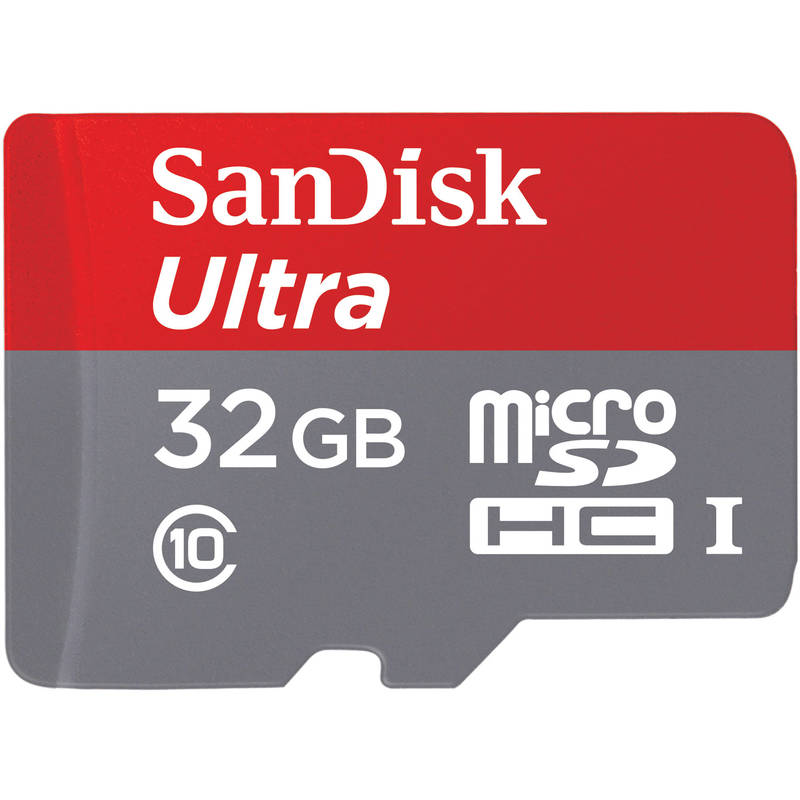
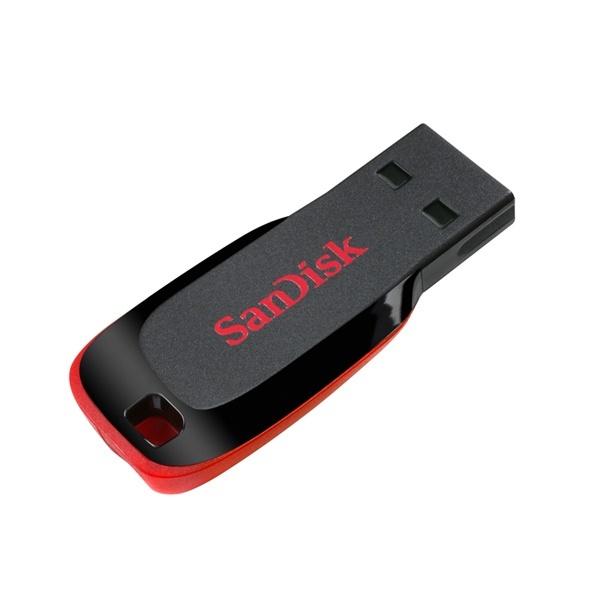
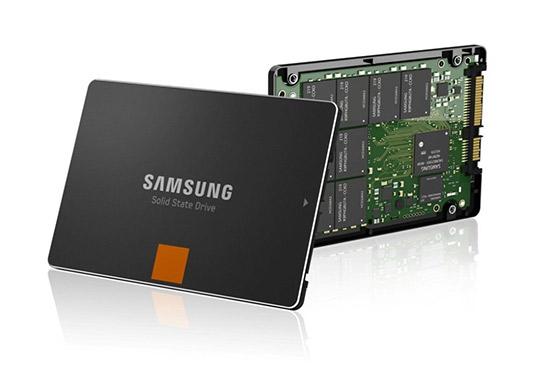
Solid state storage comes in many forms such as memory cards, usb memory sticks, solid state drives (or SSD’s) or memory chips that are soldered directly to component boards – such as in your phone.
The name solid state comes from the fact that, unlike other forms of storage such as hard disk, there are no moving parts. To confuse things further, solid state storage is often called “flash” memory. Therefore, the first thing to understand is that when we talk about solid state storage we are talking about anything which uses flash memory chips to store data and the terms “flash” and “solid state” are interchangeable.
Flash memory uses a special type of memory chip which is non-volatile, and we all know by now that this means it will not lose the contents from one power cycle to another.
So, solid state storage is:
- Any storage device which uses non-volatile, flash memory chips to store large amounts of data.
There are several different types or forms of solid state storage, these are:
- Memory Cards (SD, CF)
- USB Memory Sticks
- Solid State Drives (SSD’s)
- Internal device storage (chips) – e.g. the storage on your phone or tablet.
They all have some really, really important advantages over most other types of storage:
- Size – Flash is extremely small and so we can make very small devices with large amounts of storage
- Power – They use very little power and so are really suited to battery powered devices
- Speed – Flash is stupidly fast when compared with any other type of mass storage. They can significantly increase the speed of a computer and are often a great option for upgrading older hardware to make it more usable (classic exam question alert)
- Capacity – They are now available in large capacities, up to around 2Tb without prices being absurd
- Robustness – They do not have any moving parts and so are very, very robust – they are suitable for devices that may be moved, shocked or mistreated.
As always, there are some disadvantages:
- Cost – they are still more expensive per Gb when compared to a traditional hard disk drive – although prices are rapidly falling as time goes on.
- Longevity – they have a limited number of read/write cycles. Although clever technologies have been invented to mitigate this, all flash storage will eventually stop working – never rely on a USB memory stick as your only storage device, for example, because they will eventually begin to lose your data or not work at all.
Cloud Storage
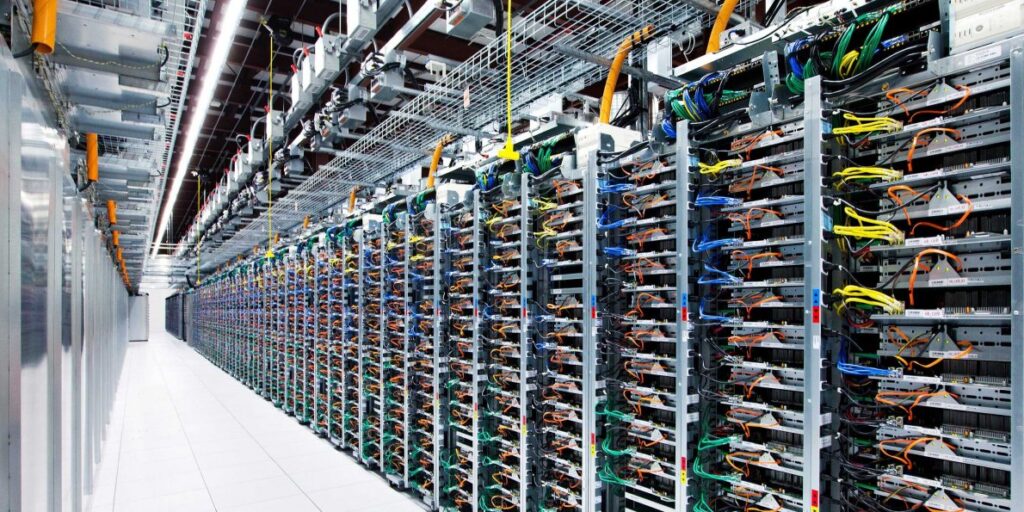
“The Cloud” is a term that gets rolled out all the time, it sounds amazing, doesn’t it? We are literally using fluffy clouds to make cool things happen! You can even store photographs in the sky, who thought it?
But we know better than that, right?
Where did the term come from? There are several possible explanations, but the most likely is that no one really knows what the internet looks like and often when you see diagrams of it, people literally just stick a cloud in the middle and write “internet” on it.
So, if the cloud is just the internet, what is “cloud computing” or “cloud storage?”
The answer is:
Cloud Computing – Using computing power or time which is remote to you (someone else owns the computer), accessed through the internet.
Cloud Storage – Storing data on a computer which is remote to you, connected to the internet. Usually this is in a data centre, owned by a large company such as Apple (iCloud Drive), Google (Google Drive), Facebook (all of your pictures of your dinner or dog), Amazon (AWS – Amazon Web Services which runs half of the internet as we know it).
Cloud storage is currently the “next big thing” and with good reason because companies can achieve huge cost savings by moving to the cloud. In reality, this means job losses because you don’t need as many technical staff, not having to buy new computers (or as often as before) and not having to worry about paying for things when they break.
Advantages:
- Cost – you do not need to buy servers, physical drives or more storage – just rent it from a cloud provider. This is a big deal as server equipment can be hugely expensive and cloud storage tends to be much cheaper.
- Maintenance – you do not need to worry about maintaining or upgrading your servers or storage
- Capacity – you can, in theory, rent as much storage space as you need. If your needs grow, you can just rent more space.
- Backup – organisations use cloud storage as backup, it’s ideal as data is stored far away from the original (a good thing). It’s also the case that you don’t need to worry about the backup of your own data – the cloud company is responsible for looking after your data.
- Access – you can access your data from anywhere that has an internet connection, giving greater flexibility to you or your organisation.
Disadvantages:
- Cost – a provider could raise their costs at any time.
- Security – you are still responsible for the security of your data (data protection act) and as your data is in cloud storage… its connected to the internet, which means it could be vulnerable to hackers.
- Access – if your internet connection goes down or your cloud provider has technical difficulties, you cannot access your data.
The right tool for the job
In the exam you can be asked about any of the types of storage in pretty much any scenario. The answer to these questions should be really, really obvious, but they won’t be if you don’t know the following:
- The definition of each type
- The typical capacity of each type
- The advantages and disadvantages
If you know your storage types then it becomes trivial to decide which one goes where. Lets look at some simple examples:
- A slim, ultra portable laptop – SSD. Why? Low power, very small physically.
- Backing up a server – Tape. Why? Standard method of backing up data, can be stored externally, robust. Cloud may be an alternative.
- Giving away some e-books on a magazine cover – CD. Why? Small amount of storage, very cheap, small.
- Storing TV programs in a set top box – HDD. Why? Cheap, huge amounts of storage (video is large), reliable, suitable for many read/write cycles
- Transferring pictures from one computer to another – Memory Stick or Memory Card. Why? Relatively large capacity, easily portable.
All of these examples use the advantages and disadvantages outlined on this page. If they look new to you… erm…
